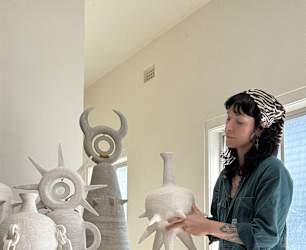Lawrence Smith is a craftsman in wood and sound. He has specialised in making fine-quality instruments since 1977. The beauty is easy to see in every piece – the craftsmanship in the wood, the shaping, the grains and the finish – but the sound of the piece is Lawrence’s prime concern.
As a child, Lawrence built model aeroplanes with guidance from his father, but his life-long passion for instrument-making was self-taught. He developed important friendships in the early 1970s with the Hay brothers of Austinmer and Jim Bennett, a Lake Heights guitar-maker, who all encouraged him.
“I made a banjo first, but later I progressed to guitars, mandolins and even lutes. I took an old arch-topped guitar and stripped it back, French-polished it and worked the tools at a local joinery that enabled me to start building a guitar.
“I was completely self-directed, though American books offered a way forward. I also learned to play the instruments and even made surfboards in fibreglass.”
Moving to a house big enough to accommodate a workshop, enabled Lawrence to perfect his skills.
“I could build here at leisure. I built steel string and classical guitars and sent them all over the world. New Zealand, the US, UK, Canada and France often featured. I generated great satisfaction from all types of instruments because they all offered very different challenges. I admit I was heavily influenced by [renowned American luthier of archtop jazz guitars] Bob Benedetto, where this jazz instrument was a natural extension of my mandolin-building experience.”
Lawrence says the finger-board is the most important consideration: “Great accuracy is needed and there are constraints and great accuracy is needed with bridge placements. Physics and science are immensely important.”
With constant application, it can take Lawrence up to two months to make an instrument.
“Just finishing an instrument by spraying and polishing takes three weeks and more with weather delays and other constraints that I cannot easily predict. It is important to understand the importance of sound and with vibrational analysis I know exactly what my instruments are going to sound like. Each guitar is hand-made and unique to my customer’s requirements.
“The woods come from all over the world. When I started, the woods were very difficult to procure. Some of my woods are 40 years old, air-dried, but all with different tonal differences.
“I was fortunate to obtain some Tasmanian King Billy Pine that grows so slowly, as well as Italian Spruce and Canadian Cedar.
“Each guitar really does not use a great deal of timber and in the past the Australian timber industry had little thought for guitar-makers, but that appears to be slowly changing as makers are offered woods that would previously have been destroyed or burned.”
The soundboard on a guitar is of prime consideration.
“My aim is to produce the lightest, stiffest, and most responsive soundboard possible. The properties of a finish can have a significant effect on the tone of an instrument. All my instruments are finished with this in mind – to enhance the figure and depth of the timber and to have the smallest impact on the acoustics of the instrument. Over time the instrument opens up and takes on a natural patina reminiscent of all great guitars.”
Lawrence’s world is one of beauty and passion in wood and sound. His dedication to skill-building and his lifelong interest is inspirational.
For more details, visit Lawrence’s website at www.smithguitars.com
Janice Creenaune is a volunteer for PKD (Polycystic Kidney Disease) Foundation Australia. Email janicecreenaune@gmail.com






